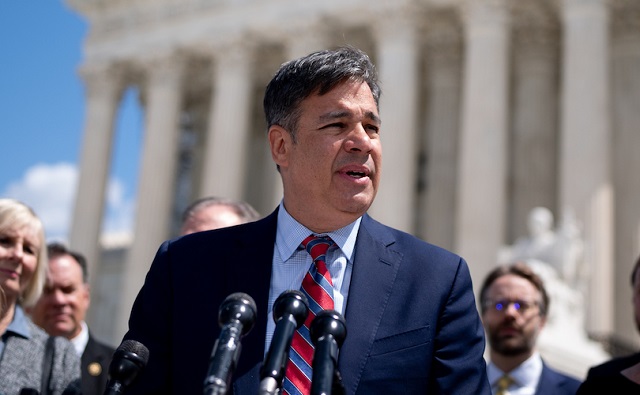Health
21 states threaten top medical group with legal action for claiming puberty blockers are ‘reversible’

Idaho Attorney General Raul Labrador
From LifeSiteNews
Idaho Attorney General Raul Labrador is leading a group of 21 states in warning the American Academy of Pediatrics that its ‘evidence-free’ endorsement of ‘transitioning’ minors violates most states’ consumer protection laws.
More than 20 state attorneys general are banding together to warn the American Academy of Pediatrics (AAP) that it could face legal action if it continues to promote surgical and chemical “transitioning” of gender-confused minors, Idaho’s top law enforcement official Raul Labrador announced Tuesday.
As previously covered by LifeSiteNews, the AAP sides firmly with LGBT activists on how to approach children suffering from gender dysphoria, endorsing the use of puberty blockers, cross-sex hormones, and surgical transformation of developing bodies, going so far as to accuse states that deny minors so-called “gender-affirming care” of “state-sanctioned medical neglect and emotional abuse.”
AAP’s position is based on “evidence free standards,” the Idaho Attorney General’s Office contends, the “most concerning” of which is its claim that the “use of puberty blockers on children is safe and reversible. This assertion is not grounded in evidence and therefore may run afoul of consumer protection laws in most states.”
“When used to suppress hormones below normal ranges during or before puberty, puberty blockers: (1) may interfere with neurocognitive development; (2) compromise bone density and may negatively affect metabolic health and weight; and (3) block normal pubertal experience and experimentation,” reads the coalition’s letter to outgoing AAP president Benjamin Hoffman and his incoming successor Susan Kressley. “And when puberty blocker use is followed directly by cross-sex hormone use, which is often the case, infertility and sterility is a known consequence, at least for those who began puberty blockers in early puberty.”
“Telling parents and children that puberty blockers are ‘reversible’ at the very least conveys assurance that no permanent harm or change will occur. But that claim cannot be made in the face of the unstudied and ‘novel’ use of puberty blockers” for gender dysphoria, it continues. “It is even less defensible now that the World Professional Association for Transgender Health and its standards of care—the AAP’s apparent cornerstone source—have been exposed as unreliable and influenced by improper pressures,” referring to revelations earlier this year that Biden administration officials pressured WPATH to remove age limits.
The attorneys general of Alabama, Arkansas, Florida, Georgia, Idaho, Iowa, Kansas, Louisiana, Mississippi, Missouri, Montana, Nebraska, North Dakota, Ohio, South Carolina, South Dakota, Texas, Utah, Virginia, and West Virginia, as well as the Arizona Legislature, went on to threaten legal consequences for AAP if it does not reverse course.
“Idaho law, for example, prohibits ‘[e]ngaging in any act or practice that is otherwise misleading, false, or deceptive to the consumer,’” the letter says. “Most other states likewise prohibit making statements to consumers that are false, misleading, or deceptive. Each of us takes our responsibility to protect consumers in our states very seriously.”
The AAP has until October 18 to answer a series of information requests about its decision-making process on the subject.
“It is shameful the most basic tenet of medicine – do no harm – has been abandoned by professional associations when politically pressured,” Labrador said. “These organizations are sacrificing the health and well-being of children with medically unproven [procedures] that leave a wake of permanent damage […] Parents should be able to trust that a doctor’s medical guidance isn’t just the latest talking point from a dangerous and discredited activist agenda.”
A significant body of evidence shows that “affirming” gender confusion carries serious harms, especially when done with impressionable children who lack the mental development, emotional maturity, and life experience to consider the long-term ramifications of the decisions being pushed on them, or full knowledge about the long-term effects of life-altering, physically-transformative, and often-irreversible surgical and chemical procedures.
Studies find that more than 80% of children suffering gender dysphoria outgrow it on their own by late adolescence and that “transition” procedures, including “reassignment” surgery, fail to resolve gender-confused individuals’ heightened tendency to engage in self-harm and suicide – and even exacerbate it, including by reinforcing their confusion and neglecting the actual root causes of their mental strife.
Many oft-ignored “detransitioners,” individuals who attempted to live under a different “gender identity” before embracing their sex, attest to the physical and mental harm of reinforcing gender confusion, as well as to the bias and negligence of the medical establishment on the subject, many of whom take an activist approach to their profession and begin cases with a predetermined conclusion in favor of “transitioning.”
“Gender-affirming” physicians have also been caught on video admitting to more old-fashioned motives for such procedures, as with an 2022 exposé about Vanderbilt University Medical Center’s Clinic for Transgender Health, where Dr. Shayne Sebold Taylor said outright that “these surgeries make a lot of money.”
Aristotle Foundation
The Canadian Medical Association’s inexplicable stance on pediatric gender medicine

By Dr. J. Edward Les
The thalidomide saga is particularly instructive: Canada was the last developed country to pull thalidomide from its shelves — three months during which babies continued to be born in this country with absent or deformed limbs
Physicians have a duty to put forward the best possible evidence, not ideology, based treatments
Late last month, the Canadian Medical Association (CMA) announced that it, along with three Alberta doctors, had filed a constitutional challenge to Alberta’s Bill 26 “to protect the relationship between patients, their families and doctors when it comes to making treatment decisions.”
Bill 26, which became law last December, prohibits doctors in the province from prescribing puberty blockers and hormone therapies for those under 16; it also bans doctors from performing gender-reassignment surgeries on minors (those under 18).
The unprecedented CMA action follows its strongly worded response in February 2024 to Alberta’s (at the time) proposed legislation:
“The CMA is deeply concerned about any government proposal that restricts access to evidence-based medical care, including the Alberta government’s proposed restrictions on gender-affirming treatments for pediatric transgender patients.”
But here’s the problem with that statement, and with the CMA’s position: the evidence supporting the “gender affirmation” model of care — which propels minors onto puberty blockers, cross-gender hormones, and in some cases, surgery — is essentially non-existent. That’s why the United Kingdom’s Conservative government, in the aftermath of the exhaustive four-year-long Cass Review, which laid bare the lack of evidence for that model, and which shone a light on the deeply troubling potential for the model’s irreversible harm to youth, initiated a temporary ban on puberty blockers — a ban made permanent last December by the subsequent Labour government. And that’s why other European jurisdictions like Finland and Sweden, after reviews of gender affirming care practices in their countries, have similarly slammed the brakes on the administration of puberty blockers and cross-gender hormones to minors.
It’s not only the Europeans who have raised concerns. The alarm bells are ringing loudly within our own borders: earlier this year, a group at McMaster University, headed by none other than Dr. Gordon Guyatt, one of the founding gurus of the “evidence-based care” construct that rightfully underpins modern medical practice, issued a pair of exhaustive systematic reviews and meta analyses that cast grave doubts on the wisdom of prescribing these drugs to youth.
And yet, the CMA purports to be “deeply concerned about any government proposal that restricts access to evidence-based medical care,” which begs the obvious question: Where, exactly, is the evidence for the benefits of the “gender affirming” model of care? The answer is that it’s scant at best. Worse, the evidence that does exist, points, on balance, to infliction of harm, rather than provision of benefit.
CMA President Joss Reimer, in the group’s announcement of the organization’s legal action, said:
“Medicine is a calling. Doctors pursue it because they are compelled to care for and promote the well-being of patients. When a government bans specific treatments, it interferes with a doctor’s ability to empower patients to choose the best care possible.”
Indeed, we physicians have a sacred duty to pursue the well-being of our patients. But that means that we should be putting forward the best possible treatments based on actual evidence.
When Dr. Reimer states that a government that bans specific treatments is interfering with medical care, she displays a woeful ignorance of medical history. Because doctors don’t always get things right: look to the sad narratives of frontal lobotomies, the oxycontin crisis, thalidomide, to name a few.
The thalidomide saga is particularly instructive: it illustrates what happens when a government drags its heels on necessary action. Canada was the last developed country to pull thalidomide, given to pregnant women for morning sickness, from its shelves, three months after it had been banned everywhere else — three months during which babies continued to be born in this country with absent or deformed limbs, along with other severe anomalies. It’s a shameful chapter in our medical past, but it pales in comparison to the astonishing intransigence our medical leaders have displayed — and continue to display — on the youth gender care file.
A final note (prompted by thalidomide’s history), to speak to a significant quibble I have with Alberta’s Bill 26 legislation: as much as I admire Premier Danielle Smith’s courage in bringing it forward, the law contains a loophole allowing minors already on puberty blockers and cross-gender hormones to continue to take them. Imagine if, after it was removed from the shelves in 1962, government had allowed pregnant women already on the drug to continue to take thalidomide. Would that have made any sense? Of course not. And the same applies to puberty blockers and cross-gender hormones: they should be banned outright for all youth.
That argument is the kind our medical associations should be making — and would be making, if they weren’t so firmly in the grasp, seemingly, of ideologues who have abandoned evidence-based medical care for our youth.
J. Edward Les is a Calgary pediatrician, a senior fellow with the Aristotle Foundation for Public Policy, and co-author of “Teenagers, Children, and Gender Transition Policy: A Comparison of Transgender Medical Policy for Minors in Canada, the United States, and Europe.”
Fraser Institute
Long waits for health care hit Canadians in their pocketbooks

From the Fraser Institute
Canadians continue to endure long wait times for health care. And while waiting for care can obviously be detrimental to your health and wellbeing, it can also hurt your pocketbook.
In 2024, the latest year of available data, the median wait—from referral by a family doctor to treatment by a specialist—was 30 weeks (including 15 weeks waiting for treatment after seeing a specialist). And last year, an estimated 1.5 million Canadians were waiting for care.
It’s no wonder Canadians are frustrated with the current state of health care.
Again, long waits for care adversely impact patients in many different ways including physical pain, psychological distress and worsened treatment outcomes as lengthy waits can make the treatment of some problems more difficult. There’s also a less-talked about consequence—the impact of health-care waits on the ability of patients to participate in day-to-day life, work and earn a living.
According to a recent study published by the Fraser Institute, wait times for non-emergency surgery cost Canadian patients $5.2 billion in lost wages in 2024. That’s about $3,300 for each of the 1.5 million patients waiting for care. Crucially, this estimate only considers time at work. After also accounting for free time outside of work, the cost increases to $15.9 billion or more than $10,200 per person.
Of course, some advocates of the health-care status quo argue that long waits for care remain a necessary trade-off to ensure all Canadians receive universal health-care coverage. But the experience of many high-income countries with universal health care shows the opposite.
Despite Canada ranking among the highest spenders (4th of 31 countries) on health care (as a percentage of its economy) among other developed countries with universal health care, we consistently rank among the bottom for the number of doctors, hospital beds, MRIs and CT scanners. Canada also has one of the worst records on access to timely health care.
So what do these other countries do differently than Canada? In short, they embrace the private sector as a partner in providing universal care.
Australia, for instance, spends less on health care (again, as a percentage of its economy) than Canada, yet the percentage of patients in Australia (33.1 per cent) who report waiting more than two months for non-emergency surgery was much higher in Canada (58.3 per cent). Unlike in Canada, Australian patients can choose to receive non-emergency surgery in either a private or public hospital. In 2021/22, 58.6 per cent of non-emergency surgeries in Australia were performed in private hospitals.
But we don’t need to look abroad for evidence that the private sector can help reduce wait times by delivering publicly-funded care. From 2010 to 2014, the Saskatchewan government, among other policies, contracted out publicly-funded surgeries to private clinics and lowered the province’s median wait time from one of the longest in the country (26.5 weeks in 2010) to one of the shortest (14.2 weeks in 2014). The initiative also reduced the average cost of procedures by 26 per cent.
Canadians are waiting longer than ever for health care, and the economic costs of these waits have never been higher. Until policymakers have the courage to enact genuine reform, based in part on more successful universal health-care systems, this status quo will continue to cost Canadian patients.
-

 Business19 hours ago
Business19 hours agoCarney’s European pivot could quietly reshape Canada’s sovereignty
-

 Alberta19 hours ago
Alberta19 hours agoAlberta’s grand bargain with Canada includes a new pipeline to Prince Rupert
-

 Crime1 day ago
Crime1 day agoManhunt on for suspect in shooting deaths of Minnesota House speaker, husband
-

 Bruce Dowbiggin3 hours ago
Bruce Dowbiggin3 hours agoWOKE NBA Stars Seems Natural For CDN Advertisers. Why Won’t They Bite?
-

 Energy4 hours ago
Energy4 hours agoCould the G7 Summit in Alberta be a historic moment for Canadian energy?
-

 Crime4 hours ago
Crime4 hours agoMinnesota shooter arrested after 48-hour manhunt
-

 conflict5 hours ago
conflict5 hours ago“Evacuate”: Netanyahu Warns Tehran as Israel Expands Strikes on Iran’s Military Command
-

 Aristotle Foundation1 hour ago
Aristotle Foundation1 hour agoThe Canadian Medical Association’s inexplicable stance on pediatric gender medicine





